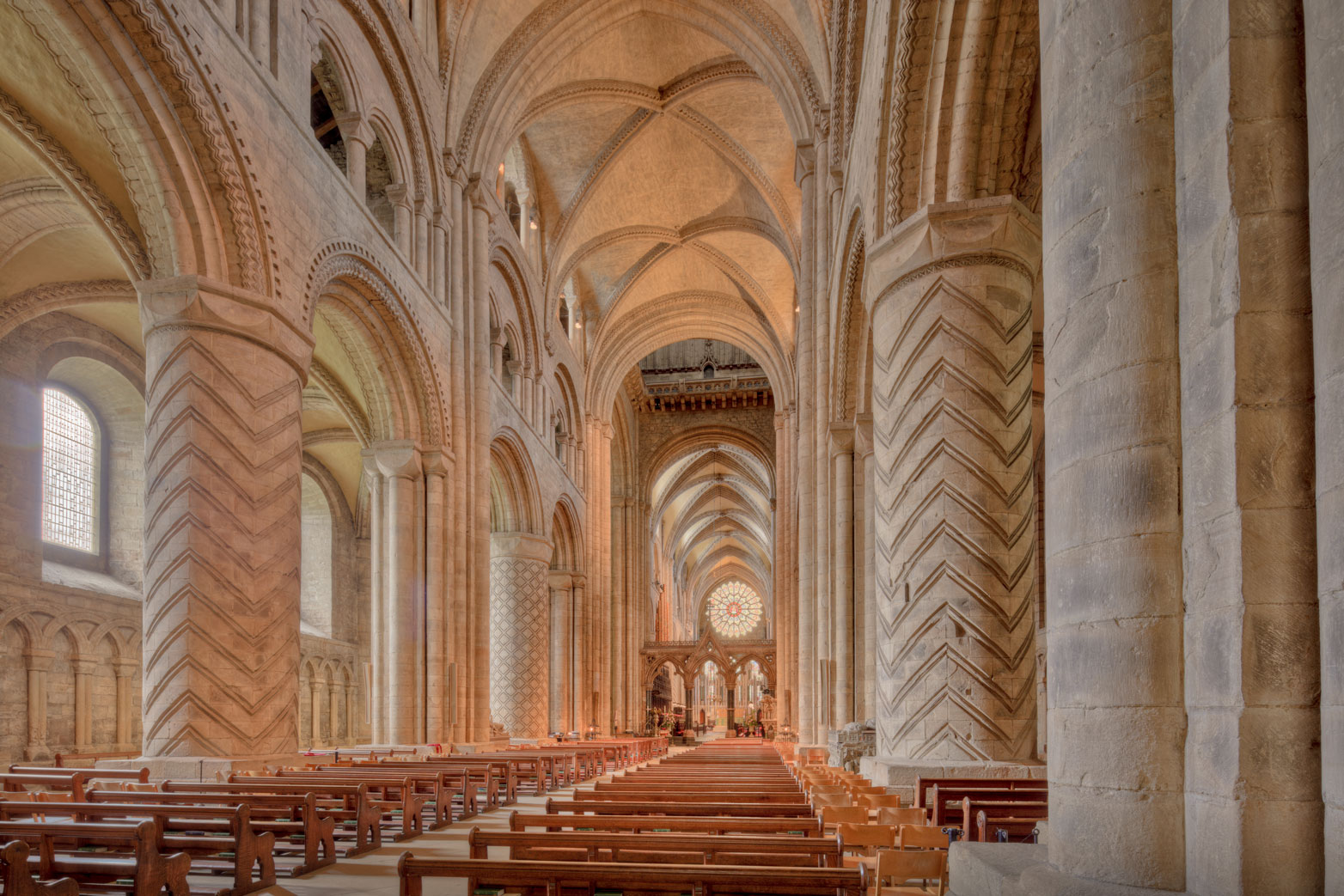Durham Cathedral, built by Britain’s Norman conquerors between 1093 and 1128, is covered in zigzags. Recently voted the “best building in the world” by a panel of 50 architectural experts (the Taj Mahal and the Parthenon came second and third, respectively), it was the U.K.’s first cathedral to be inscribed on UNESCO’s list of World Heritage Sites, internationally recognized as a Romanesque masterpiece. Why do zigzags occur here for the first time in England and in such profusion? Art historians rarely ask such questions. They simply accept it as a given that the Normans “invented” the zigzag pattern and look no further.
Why does knowing where the zigzag came from matter? Its importance, in my view, stems from its role in challenging a term like “Romanesque,” only coined in France in the 19th century, a term which implies a European origin of styles, patterns and techniques, even though many typical “Romanesque” features began their life far from Rome. The story of the zigzag helps a 21st-century audience think about architecture differently and realize that nothing is random. Ancient people’s early choices of decoration shed light on their attempts to comprehend the world around them. Once we are connected to this deeper past, we can grasp how archetypal patterns — like zigzags — have been passed down through buildings as part of our cultural heritage. What we think of today as “national” styles can thus be better appreciated as the hybrid, multi-influenced architectural achievements that they are.
The eureka moment that unlocked the zigzag secret for me came in late 2020 when watching the first episode of the BBC documentary “The Secret History of Writing.” Tracing the origins of the world’s earliest-known phonetic alphabet, the presenter climbs with her guide to the remote 400-meter-high plateau known locally as Serabit al-Khadim (Arabic for “Stelae of the Servant”), a turquoise mine in Egypt’s Sinai Peninsula. Familiar to me from many a camping weekend during a four-year stint in Cairo, the stelae form part of the 1850 BCE Temple of Hathor and are covered in hieroglyphs. As “Mistress of Turquoise,” Hathor was the patron of miners and goddess of the Sinai, where all of Ancient Egypt’s precious turquoise and copper mines were located.
Yet this particular mining site holds a surprise. Scratched on stones, on the walls of a mine not far from the temple of Hathor, are symbols of what is now called Proto-Sinaitic or Proto-Canaanite. In this revolutionary new writing system, invented by migrant workers from the Levant, pictorial hieroglyphs have been turned into phonemes, thereby forming a new alphabet based solely on sounds. The hieroglyph for water is a zigzag horizontal line, so the Canaanite workers chose the zigzag to represent the sound “m,” the first letter of their word for water — “maym” or “mayeen.”
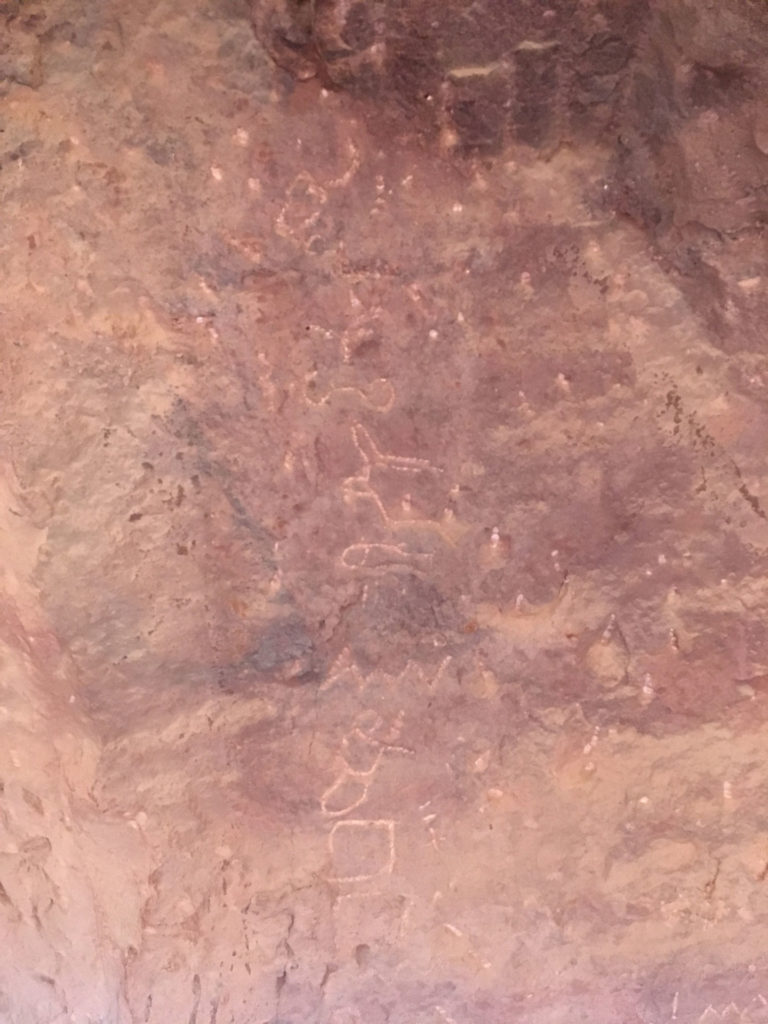
From Sinai, the migrant workers carried their new writing system back home, where the Phoenicians adopted it and spread it across the Mediterranean. All the alphabets of the world, excepting the 20th-century creations such as Korean, but including the one I am writing with now, are acknowledged to derive from that one source at Serabit al-Khadim. What an invention, not by educated elites, but by ordinary laborers (you can read more about this phenomenal invention in a previous New Lines essay).
The episode of “The Secret History of Writing” which sparked that eureka moment begins and ends with a coincidental, but for my purposes very fitting, flourish: The presenter walks through an arched doorway heavily decorated with zigzags into the Round Church in Cambridge. Built by a mysterious Norman fraternity of Jerusalem’s Holy Sepulchre in 1115-31, the building is contemporary with Durham Cathedral.
As soon as I had that zigzag-water epiphany, I contacted a Syrian friend now living in my house in Damascus and asked him to send me a photo of the zigzag pattern round the courtyard walls, specifically of where it began and ended, at the arch of the iwan, the cool, north-facing sitting area shaded from the summer sun. What he sent back was another surprise, something I had never noticed before in all my years of sitting in that courtyard. On the right-hand side, the zigzags — in red, green and black — emerged, not right from the arch base, but from a self-contained circle, representing a definite starting point, clearly a spring, as the water source. They then ran, uninterrupted, all round the courtyard walls to the left-hand arch base, as if they would run on into infinity, symbolizing the water that flowed in, not just to the fountain at my courtyard center, but to all water sources in the house, before it flowed out again and into the next house, and so on and on forever. Damascus was built on an elaborate and ingenious water system, first devised by the Arameans, and later expanded by every subsequent set of rulers, especially the Ottomans.
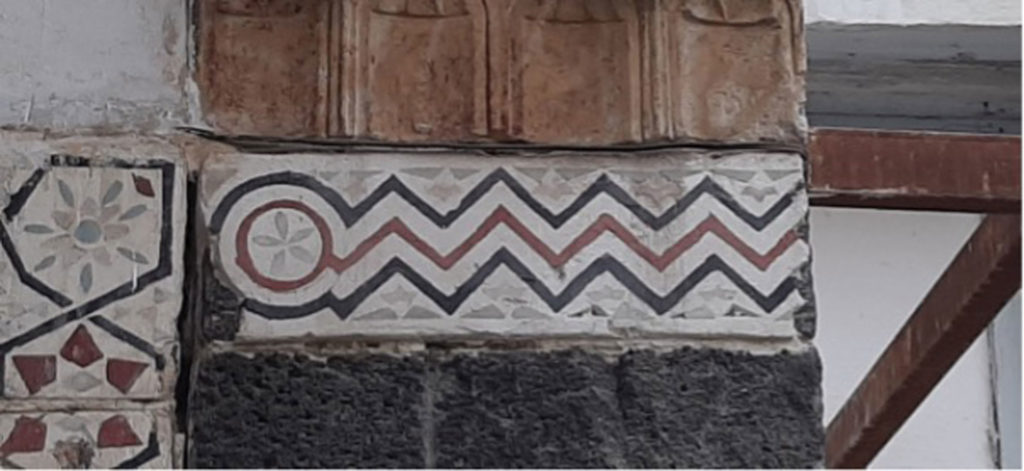
Starting from that remarkable connection, which could never have been made in months or even years spent studying in libraries, I began to trace the zigzag through successive Egyptian dynasties, through their Coptic descendants, and into the decorative repertoire of the earliest Islamic dynasty, the Umayyads, where it bursts out in dramatic fashion on the facade of Mshatta, a desert winter palace. The palace still stands today as a ruin beside the perimeter fence of Jordan’s Queen Alia International Airport, but its stunning 8th-century zigzag facade was shipped to Berlin as a gift from the Ottoman Sultan Abdul Hamid II in 1903 to Kaiser Willhelm II in gratitude for the German role in the construction of the Hejaz Railway. Despite suffering severe damage in World War II from Allied bombing, it is now on display in Berlin’s Pergamon Museum, where it can be examined up close as the spectacular entrance to the Museum of Islamic Art. Its complex blend of geometry and natural motifs is typical of Umayyad art, positively erupting with the effusive energy of nature. The Umayyads displayed consummate skill and a total command of water and irrigation systems at all their desert palaces. Accustomed as they were to arid environments, water management was essential to their survival. The zigzag pattern that dominates the carved limestone facade surely represents the life-giving water that flows through the lush vegetation where sculpted beasts and birds are intertwined in the foliage. The great art historian K.A.C. Creswell (1879-1974), in his seminal work “Early Muslim Architecture,” observes that in the center of each of the 20 zigzags is a different rosette: some are hexagons, some octagons, and each has a different kernel, demonstrating the extraordinary richness of Umayyad stonemasonry skills.
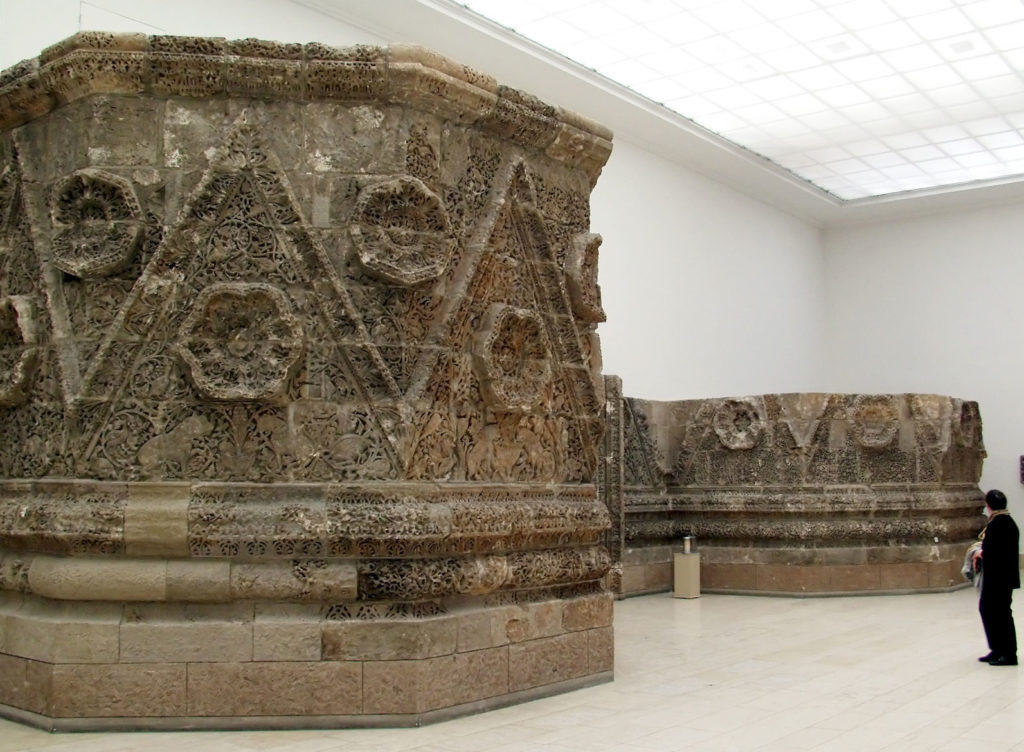
The zigzag also appears in Abbasid patterns in Mesopotamia, but reached its zenith under the Fatimid caliphs at al-Qahira (Arabic “the Victorious”), modern-day Cairo, the capital they founded in 973. Among all the dynasties that ruled the Islamic world during the medieval period, the Fatimids (909-1171) were arguably the most active in their patronage of the arts and the most distinctive in their style. Named after the Prophet Muhammad’s daughter Fatima, they were a highly energetic sect of Shia Muslims known as Ismailis, who first rose in the Syrian desert at Salimiye in opposition to the orthodoxy of earlier Sunni Umayyad and Abbasid caliphates. For over 200 years, they dominated trade in the Mediterranean, extending their reign over much of North Africa. For our zigzag purposes, however, the most important fact to focus on is that they were contemporary with the Normans — and indeed with the so-called Romanesque period.
The great wealth of the Fatimids derived from the life-giving waters of the Nile and their extensive commercial ties with Europe, India and the Far East, which allowed them to spend lavishly not only on grandiose building projects but also on sponsoring the production of luxury items like textiles, ceramics, carved wood, ivory and rock crystal. Relatively few of their architectural achievements in Cairo have survived — just a handful of mosques like al-Azhar and al-Aqmar. Zigzags feature prominently in what does remain, seen in mosque arches and domes, and were then carried over into Mamluk architecture, as at Cairo’s Mosque of Baybars.
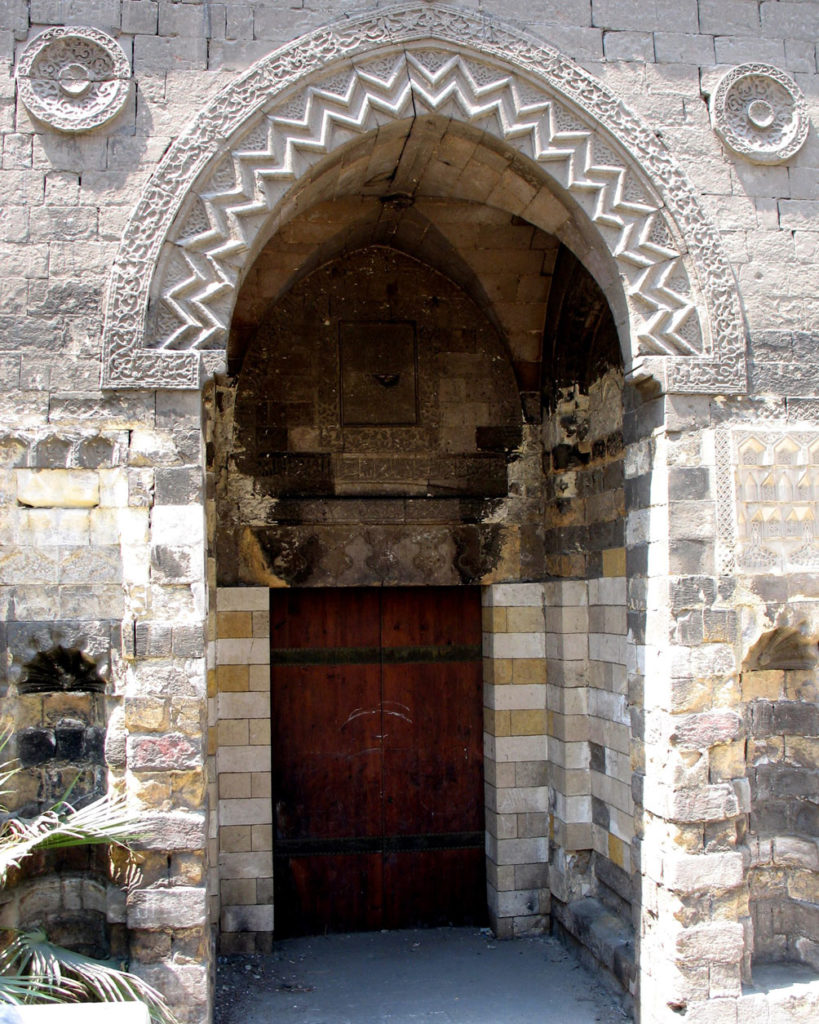
Many Fatimid luxury items, on the other hand, have survived the test of time and are scattered across museums around the world. Both London’s British Museum and the Victoria and Albert boast their share. Some, like rock crystal ewers, are credited with magical powers, and often found their way into the treasuries of European cathedrals, abbeys and basilicas. Saint-Denis in Paris holds one such object, gifted to Theobald the Great by Roger II of Sicily on the occasion of his son’s marriage to Theobald’s daughter, then later given to Abbot Suger, regent of France during the Second Crusade, in an example of how precious objects passed between elites across cultures in highly influential ways. The motifs carved on these translucent ewers were often fantastical birds, beasts like lions and twisting tendrils so typical of Romanesque architecture, as seen on the Mshatta facade centuries earlier.
The Normans invaded Sicily and southern Italy piecemeal from 999 on, taking many decades to complete the conquest and establish the County of Sicily in 1071, followed by the Kingdom of Sicily in 1130. Fatimid and Norman fates first intertwined in the Emirate of Sicily (827-1091), when Egypt was majority-Christian and Sicily majority-Muslim. After the violence of the initial conquests, both societies were pluralistic, inclusive and tolerant, and they overlapped culturally at all levels. Fatimid carpenters, for example, were summoned from Cairo by the Norman kings around 1140 to build the wooden “muqarnas” ceiling of their private royal chapel, the Cappella Palatina. Noblemen, merchants, masons, craftsmen and pilgrims of all faiths moved freely between Fatimid and Norman spheres of influence.
But I was still taken aback, on a recent trip to Sicily, to be confronted with zigzags in profusion and in positions of prominence in so many Norman buildings.
Norman mercenaries first came to Sicily fighting for the Byzantines, but then cast off their paymasters and took over the island themselves. They kept the capital Palermo, first founded by the Fatimids, as their own capital, adapting and incorporating the extant Arab palaces and refashioning Fatimid mosques into churches. Palermo is covered in such monuments, nine of which were acknowledged by UNESCO in 2015 as worthy of a group World Heritage Site listing. Citing what it calls “Arab-Norman” Palermo of the era of the Norman Kingdom of Sicily (1130-1194) as an “outstanding example of stylistic synthesis,” the UNESCO description states that this collection of buildings “bears witness to a particular political and cultural condition characterized by the fruitful coexistence of people of different origins (Muslim, Byzantine, Latin, Jewish, Lombard, and French).” This interchange, it continues, “generated a conscious and unique combination of elements derived from the architectural and artistic techniques of Byzantine, Islamic, and Western traditions. This new style contributed to the developments in the architecture of the Tyrrhenian side of southern Italy and spread widely throughout the medieval Mediterranean region.” This acknowledgment of Islamic influence comes better late than never, though in my view it unfairly credits Byzantine, Islamic and Western traditions equally, when the real innovations — in stonemasonry skills, ribbed vaulting techniques and decorative repertoire — were overwhelmingly Islamic, not Byzantine or Western.
Norman masons were able to learn these new techniques and carry them back to France, not from Byzantine or Western sources, but from Muslim masons still working on the island and from the pre-existing Islamic structures. It is recorded that the Normans destroyed many Arab towns and buildings on the island initially, but since the population of the island was majority-Muslim, after the initial conquest, they needed the cooperation of the indigenous people to stay in power. They therefore decided to maintain good relations with them, incorporating Muslims at high levels of government and employing Muslim craftsmen to build their hybrid Arab-Norman palaces and churches, whose Arab styles they evidently admired and found aesthetically pleasing.
As for zigzags, none occur in Byzantine or Western decorative architecture anywhere on European soil before their appearance in Sicily in the 11th century. Their most prominent appearance comes in Roger II’s Throne Room within the Norman Palace at Palermo, where they form the foundation of the symmetrical composition in a key mosaic symbolizing royalty and fertility — a set of red and green zigzags under the feet of two facing lions, raising their paws to the central date palm laden with fruit and flanked by a further pair of trees.
At the Benedictine cloister of Monreale Cathedral (1172) on the outskirts of Palermo, the striking column fountain in the courtyard is deeply incised with zigzags, as are some of the surrounding columns. The arches of the cloister itself are all decorated with them, alongside wild creatures embroiled in the foliage of the carved capitals. At La Zisa, also on Palermo’s outskirts, the Arab Room marble fountain, which served as the model for the Arab Hall at London’s Leighton House, is carved with zigzags on the surface where the water runs, as indeed are most such fountains across the Islamic world.
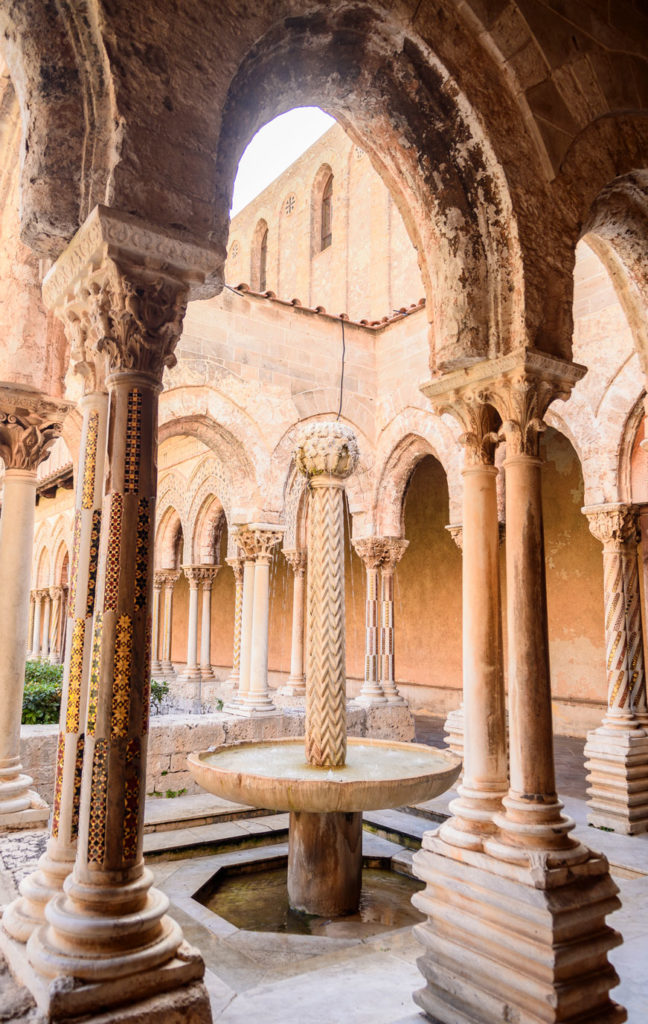
Palermo Cathedral (1185), formerly the city’s main Fatimid mosque, and Norman tombs in Palermo cemeteries like Sant’Orsola are also heavily decorated with zigzags and other features of Islamic architecture, so much so that it’s easy to forget these are not Islamic graveyards but Christian ones. All the architectural evidence clearly shows that Sicilian Muslim stonemasons began to pass their skills over to their Norman Christian counterparts and that zigzags entered into Norman culture in Sicily.
Throughout the 12th century, the Normans brought these styles and craftsmen back to France and began to build structures like the Benedictine and Cluniac Vézelay Abbey (1120-50) on the pilgrim route to Santiago de Compostela. Recognized by UNESCO as a World Heritage Site as early as 1979, the abbey is widely deemed a masterpiece of Burgundian Romanesque, while its zigzag arches and rib vaulting remain unrecognized as Sicilian Islamic borrowings. These features, which require a far more advanced understanding of geometry than was present in Europe at that time, then begin to appear in France’s early Gothic cathedrals, abbeys and basilicas like Saint-Denis (1135), Sens (1140) and Senlis (1160).
Particularly ironic, in the light of such Islamic sophistication, is the famous lintel of the Vézelay portal which portrays the “heathens,” namely the “godless” Arabs and Turks, as physically backward and grotesque, with pig snouts, elephantine ears and other deformities. Bernard of Clairvaux, founder of the strict Cistercian branch of the Benedictines, preached in favor of the Second Crusade at Vézelay, and the deliberate dehumanization of the non-Christian “enemy” in this way, more political than religious, was consistent with Pope Urban II’s call for the First Crusade, as a mission to capture the Holy Land and “exterminate this vile race.”
Zigzags and other Arab elements also passed into European architecture through Italian cities like Amalfi, another major trading partner of Fatimid Cairo. The Holy Roman Emperor Conrad II ordered the construction of the Christian Western world’s largest-ever church in Speyer (1030-83), overlooking the Rhine. Along with the cathedral of Santiago de Compostela (1075), Cluny Abbey (1085) and Durham Cathedral (1093), it was one of the most ambitious projects of its time. Zigzags feature copiously in the decoration round Speyer’s arches and on the ribs of the vaulting at Santiago de Compostela.
When the Normans invaded England in 1066 under William the Conqueror, construction techniques underwent a giant leap forward in the country. The ribbed vaulting seen in Durham Cathedral was clearly not the work of indigenous laborers. Further clues can be found in the fact that Prince-Bishop William de St-Calais, the Norman knight/monk who was made bishop of Durham and who took charge of the cathedral construction, is said to have brought with him from France Muslim masons captured on campaign in Sicily. The sudden appearance of fantastical beasts and arabesque and geometric patterns including the zigzag and chevron seen in buildings across England at this time, clearly shows the Arab Fatimid influences acquired by the Normans in Sicily.
There are many unacknowledged Eastern Mediterranean and Islamic influences on view in “Romanesque” architecture. The more closely the evidence in the buildings themselves is examined, the clearer the patterns become. In essence, the thousands of “Romanesque” buildings across Europe stand as reflections of the varied and eclectic sources from which they derived their inspiration — hardly restricted to Rome.
Conversely, zigzags, far from being restricted to a narrow Romanesque motif, have entered the mainstream — forgive the pun. Walking from Durham Cathedral to the railway station, my zigzag-obsessed eye noticed the pattern on a manhole cover.
How apt that the rich symbolism of the zigzag, seen long ago in Ancient Egypt, should have remained the same not only under both Fatimid and Norman rulers, but up to the present day. It has passed into our iconography in ways we rarely notice. Once its significance is pointed out, the trained eye will start to spot it all across Europe, leading to a zigzag revelation that forces us to reassess old assumptions and offers new insights into the style we call “Romanesque.” In an age of political division and isolationism, such realizations help us appreciate how shared cultural connections unite us across national borders. In short, zigzags should be celebrated as the cross-cultural phenomena that they are.



